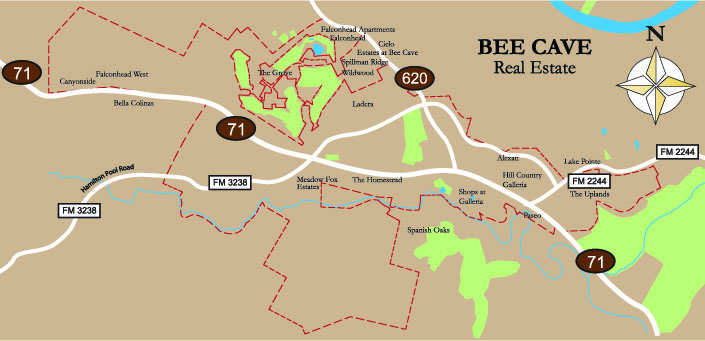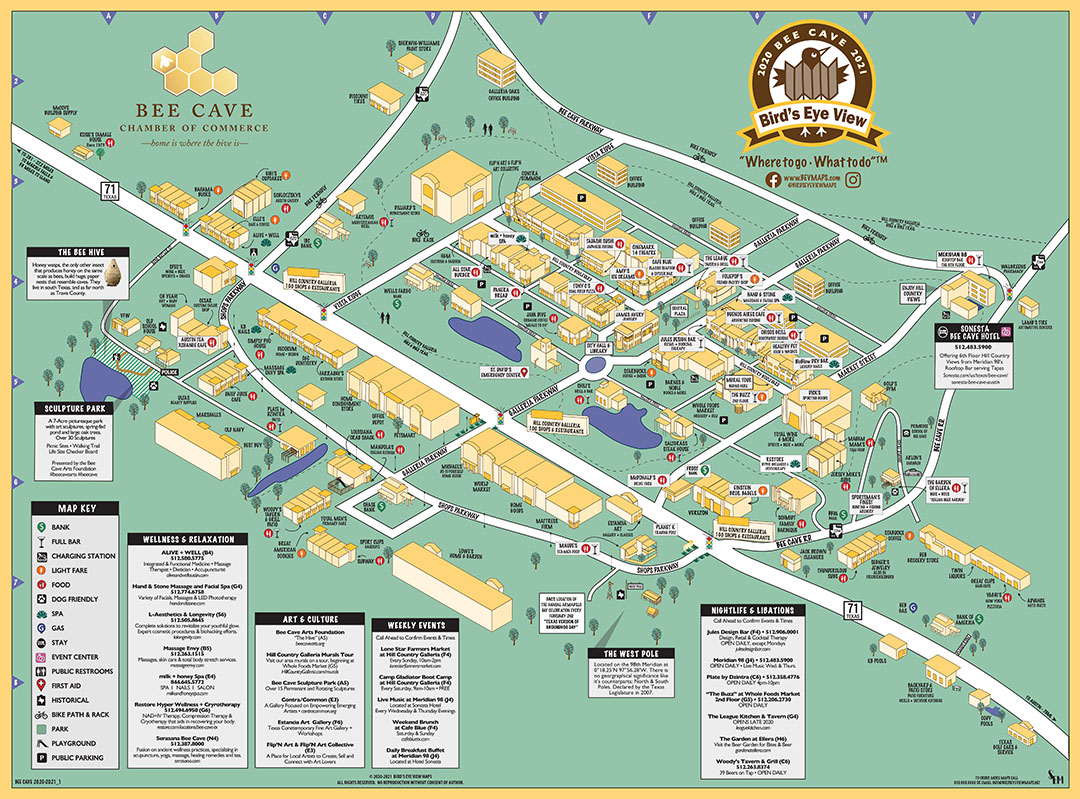Location – Location — Location
Welcome to Bee Cave, Texas!
Just 17 miles west of Austin, Bee Cave is a Texas gem known for its relaxation and entertainment, offering year-round activities like shopping, dining, golfing, water sports, and hiking amid stunning Hill Country views. Once a quiet spot named for a limestone cave swarmed by bees, it has transformed into a vibrant destination showcasing southern hospitality.
The heart of Bee Cave is on HWY 71 between FM 2244 (Bee Cave Road) and RR 620, just 15 miles west of downtown Austin, TX.
Austin-Bergstrom International Airport (AUS) is 22 miles east of Bee Cave.
Fun Fact: The West Pole is located on the 98th meridian in Bee Cave, Texas. Unlike the North and South Poles, it has no geographic significance; it is more of a gag for publicity, tourism, or local fun, declared by the Texas Legislature to be located “in Bee Cave, Texas…to add to the greatness of Texas”. It is the location of the annual Armadillo Day celebration (a local or Texas version of Groundhog Day) every Feb. 2nd. It is located at 30°18.25′N 97°56.28′W. Reference & to read more CLICK HERE.
Attractions & Lodging
Bee Cave is home to several area attractions for shopping, dining, hiking, and events. These are just a few of the area’s highlights.
Education
The Lake Travis Independent School District serves the growing area of Lake Travis, including Bee Cave, located approximately 20 miles west of Austin, Texas. Originally a component of the Dripping Springs ISD, Lake Travis ISD was formed on June 12, 1981. At that time, 541 students were enrolled in grades K – 12. Since then, District enrollment has increased to approximately 8,300 students in eight campuses, including:
- Bee Cave Elementary (Grades K-5)
- Lake Pointe Elementary (Grades K-5)
- Lake Travis Elementary (Grades EE-5)
- Lakeway Elementary (Grades K-5)
- Serene Hills Elementary (Grades K-5)
- Hudson Bend Middle (Grades 6-8)
- Lake Travis Middle (Grades 6-8)
- Lake Travis High (Grades 9-12)
- International School of Texas (Grades Pre-K-8)
For more information about the Lake Travis Independent School District please visit: www.laketravis.txed.net
For more information about International School of Texas please visit: https://internationalschooloftexas.com/
Real Estate

History
The City of Bee Cave is rich in history. The City, as we know it today, did not exist until 1987, but the idea of an area where people could live without the influence of “big city” government has been the area’s “calling card” for over 140 years.
As early as the 1850s, Dietrich Bohls moved from Austin to his new home at the confluence of Barton Creek and Little Barton Creek. The population of Austin had reached 900 people, and Mr. Bohls was looking for a place to raise his family away from the confines of the city and its influence. At the time, the land west of Austin still had Native American inhabitants, and therefore, other settlers in the area were scarce. The Bohls family was one of the first families to settle on the land that would become the Village of Bee Cave. Some of the original structures still exist today.
In the 1860s, western Travis County was booming; it was becoming a popular place for families to establish their home. They cleared the land with a lot of hard work and sweat. The rocky cedar breaks beneath the Hill Country soil was not the best for farming. Most of the settlers, however, were proud, friendly people who wanted to be left alone on the quiet of their farms to raise their children. As more and more settlers like the Freitags, Ottens, and the Pechts moved to the region, it became known as “the Bee Caves area”. The area derived its name from the colonies of Mexican honeybees that lived in the banks of Barton Creek and Little Barton Creek that encompassed a large area of Western Travis County.
In the early 1870s, Mr. Carl Beck arrived in the area and opened his general store at the crossroads of what are now State Highway 71 and Hamilton Pool Road. Settlers and travelers would stop in the Beck Store to buy supplies, mill their cotton, exchange news, and collect their mail. He also built a cigar factory and cotton gin. In 1873, Mr. Beck became postmaster and opened the post office in his store. Needing a name for his post office, Mr. Beck thought about the bees in the banks of the creek behind his property, and of the bee hives (or caves) that the bees would build in the eves of local buildings. As a lark, he named the post office for the surrounding area he called “Bee Cave”.
Local people worked together to build a school building on land given to the Bee Cave community by the Freitag family. The area families were a close-knit group, and if a family needed help, the people were eager to assist their neighbor.
As the years passed and more families moved to the area, the Wallace Store was built across from the school, and later the Johnson Store was built to the south of the school. The core of the Bee Cave community was confined to a two-mile section of crossroads that provided connections to Marble Falls, Teck, the Hudson Bend area and several communities to the west. Over one hundred years later, in the 1980s, the community still retained its slow pace and friendly atmosphere.
In the 1980s, the City of Austin began to attempt numerous annexations. In order to avoid being annexed by Austin, several communities in outlying areas, areas such as Creedmoor, Bertram and Mustang Ridge, voted to become incorporated.
Many people who lived in the Bee Cave area were also concerned about possible annexation, and therefore, a group of local citizens formed a board known as the Concerned Landowners and Citizens Organization (CLACO). The five founding members were Judy Figer Allen, Gilbert Wallace, Kenneth Spell, Robert Baldwin, Sr. and Rodney Bohls. The board had to overcome many obstacles that were impeding the process of incorporation, including entities such as Travis County, the City of Austin, the Sierra Club, as well as several other environmentalist groups, but eventually, the Village of Bee Cave incorporated in 1987
With key support from State Representative Terrell Smith and State Senator Gonzalos Barrientos, the Village was allocated one-mile of extraterritorial jurisdiction, instead of the standard one-half mile extraterritorial jurisdiction (ETJ; explained in future detail in later sections) that incorporated areas equal in size to the Village are allowed by state law. The additional ETJ area prevented the division of four old land grants. In 1987, the Village of Bee Cave administration had its humble, but proud, beginning in a nondescript portable building. The Village encompassed a two-square-mile area with 8,800 acres of extraterritorial jurisdiction. The 1990 population was approximately 214 people, and the establishment of the Village of Bee Cave was official. By 2000, the Village had grown to 656 people.
In 2006, the “Village of Bee Cave” changed its official name to “City of Bee Cave.
**History found in City of Bee Cave Comprehensive Plan



